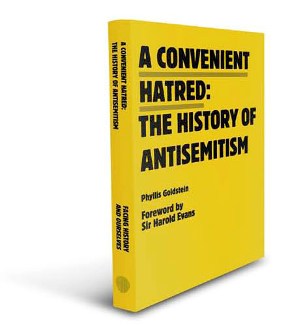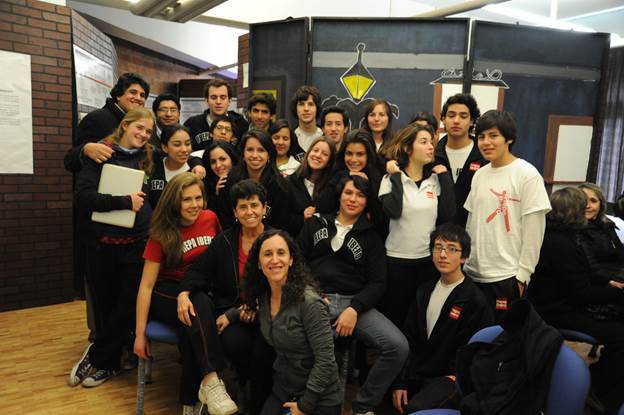The workshop is geared toward participants in Latin America and will explore questions like, “How do myths and stereotypes become part of a culture?” and “When does hatred become convenient?”
 Dr. Yael Siman, a professor at Universidad Iberoamericana in Mexico City, Mexico, will lead the workshop. We sat down to talk with Dr. Siman, who also works with high school students at Prepa Ibero, which is located on the university campus and was the first international school in Facing History’s Innovative Schools Network. Below, Dr. Siman discusses Facing History’s book A Convenient Hatred: The History of Antisemitism, which workshop participants will read, and talks about why young people in Latin America – as well as people of all ages, in all places – should learn about the history of hatreds such as antisemitism in order to create a more tolerant society today. Read on – and don’t forget to register for the workshop!
Dr. Yael Siman, a professor at Universidad Iberoamericana in Mexico City, Mexico, will lead the workshop. We sat down to talk with Dr. Siman, who also works with high school students at Prepa Ibero, which is located on the university campus and was the first international school in Facing History’s Innovative Schools Network. Below, Dr. Siman discusses Facing History’s book A Convenient Hatred: The History of Antisemitism, which workshop participants will read, and talks about why young people in Latin America – as well as people of all ages, in all places – should learn about the history of hatreds such as antisemitism in order to create a more tolerant society today. Read on – and don’t forget to register for the workshop!
Scroll down to read this post in Spanish!
Facing History and Ourselves: Thanks for joining us, Dr. Siman! We’re looking forward to the online workshop. Why do you think people should register for it? What will participants learn from this online workshop?
Dr. Siman: In this workshop, we will look at the particular history of antisemitism, as well as the ways in which other hatreds can take root in a culture, how they evolve, and why they persist over time. Participants will come away with strategies and educational resources that will allow them to replicate the seminar in their own work and in their own communities.
From studying this history, participants in this workshop will see that while hatred is part of human behavior, it is not inherent to human nature. While some people, groups, and governments mobilized or easily manipulated antisemitic stereotypes or myths throughout history, others chose to reject them, or to publish edicts or charters that protected the religious rights of the Jewish minority in difficult times.
Why is it important that we study the stereotypes and myths that contribute to certain hatreds, including antisemitism?
Studying when a stereotype or a myth becomes rooted in a society can shed light on the shared needs, fears, anxieties, and tensions of a people and of an era. It can teach us about the the many paths that can ultimately lead to humiliation, exclusion, and violence.
Stereotypes and myths are at the core of any hatred. By studying them we can understand a big part of the history of hatred, including antisemitism. By looking at events such as accusations of deicide (the killing of a god) to blood libel and conspiracy theories, we learn about the origins, development, social roots, pervasiveness, and persistence of antisemitism over time. Throughout history, people have used both stereotypes and myths to mobilize political support or strengthen collective identities. They have also used myths and stereotypes to dehumanize and demonize the “other” while inciting hatred or justifying violence.
Interestingly, I think that by studying stereotypes and myths we become aware of the far more complex reality on which those stereotypes and myths are based. Examining their emergence and evolution will hopefully lead us to question their faulty underlying assumptions. This history is a warning to all of us about the potential destructive impact of simplistic images and powerful lies, especially when they become widely shared and largely unquestioned.
In this workshop, participants will read and study A Convenient Hatred. You’ve read the book. Has it impacted your teaching?
I was completely transformed by reading A Convenient Hatred. It made me more aware of the importance of historically tracing the origins of any hatred. In the case of antisemitism, some origins go back to well before early Christianity. Reading it helped me to realize the importance of focusing on the history of one hatred in order to better grasp its complexity. And it helped me to understand how, in acquiring a deep historical knowledge of a hatred such as antisemitism, we can then make connections between the past and the moral dilemmas of our time.
This workshop is geared toward participants in Latin America. Why is it important to offer this workshop to a Latin American audience?
Many of the leading academic texts and articles on antisemitism have not been translated into Spanish and this opportunity really marks the first time that a professional development opportunity on antisemitism of this quality and richness will be offered in the language.
Antisemitism has been present over time in different parts of the world, and Latin America is no exception. Even while some of our societies are increasingly democratic, we still face intolerance and discrimination on religious grounds. In Mexico, for example, where I live, legislation explicitly prohibits religious discrimination, but surveys conducted by the National Council for the Prevention and Elimination of Discrimination (Conapred-Enadis) show a complex reality. In 2010, a large majority of the population surveyed the Mexican population (70%) said that it is a positive thing to have a religiously diverse society, yet 35% said that religion “to a great extent” provokes divisions.
Why should young people in Latin America study the impact of antisemitism over time?
Educating the young is certainly very important for building a culture of tolerance in our countries. Latin America is largely a region of young people. In the case of Argentina, Mexico, and Venezuela, for example, people between the ages of 15 and 24 represent 15 -19% of the population. If we also consider younger kids and adolescents, these percentages are much higher (between 40 and 50% depending on the country).
If educated about the negative impact of antisemitism over time, young people can become better equipped to identify early warning signs of religious intolerance in their own communities today.
***
Hacia finales de marzo, Facing History conducirá un taller virtual gratuito en español sobre la historia del antisemitismo: “Un Odio Conveniente – La Historia del Antisemitismo.” El taller está dirigido a participantes en América Latina y examinará interrogantes como las siguientes: ¿Cómo se convierten los estereotipos y los mitos en parte de una cultura? ¿Cuándo se vuelve conveniente un odio? La Dra. Yael Siman, profesora de la Universidad Iberoamericana en la Ciudad de México (UIA), será la facilitadora del taller. Entrevistamos a la Dra. Siman, quien también trabaja con estudiantes de la Prepa Ibero, institución que se encuentra en el campus universitario de la UIA y la cual fue la primer escuela internacional en la Red de Escuelas Innovadoras de Facing History. Más abajo, la Dra. Siman presenta su opinión sobre A Convenient Hatred (Un Odio Conveniente), un texto que leerán los participantes del taller, y discute por qué es importante que los jóvenes de América Latina –al igual que toda persona, de cualquier edad- aprenda sobre la historia de odios como el antisemitismo con el fin último de crear una sociedad más tolerante en nuestros tiempos. Continúa leyendo – ¡y no olvides registrarte en el taller!
Facing History: ¡Gracias por acompañarnos, Dra. Siman! Estamos entusiasmados con el próximo taller virtual. ¿Por qué cree que es importante registrarse en el taller? ¿Qué aprenderán los participantes en este taller virtual?
Dra. Siman: En este taller, exploraremos la historia particular del antisemitismo, así como las distintas maneras en que otros odios se arraigan en una cultura, cómo evolucionan y por qué persisten a lo largo del tiempo. Los participantes aprenderán estrategias didácticas y conocerán recursos educativos que les permitan replicar el taller en su propio espacio de trabajo y en sus comunidades.
A partir del estudio de esta historia, los participantes del taller entenderán que si bien el odio es parte de la conducta humana, no es algo inherente a la naturaleza humana. A pesar de que hay personas, grupos y gobiernos que históricamente movilizaron o manipularon fácilmente los estereotipos y los mitos, otros eligieron rechazarlos, o publicar edictos y cartas que protegían los derechos religiosos de la minoría judía en momentos difíciles.
¿Por qué es importante que estudiemos los estereotipos y los mitos que contribuyen a ciertos odios, incluyendo al antisemitismo?
El estudiar en qué momento un estereotipo o un mito se arraiga en una sociedad puede arrojar luz sobre las necesidades, miedos, ansiedades y tensiones compartidas por un pueblo, y una época particular. Podemos aprender sobre los diferentes caminos que conllevan a la humillación, la exclusión y la violencia.
Los estereotipos y los mitos son centrales para cualquier odio. Al estudiarlos podemos conocer gran parte de la historia del odio, como el antisemitismo. Al analizar eventos como la acusación del deicidio (el asesinato de un dios), el libelo de sangre y las teorías de conspiración, podemos aprender sobre los orígenes, el desarrollo, las raíces sociales, la ubicuidad y la persistencia del antisemitismo a lo largo del tiempo. Históricamente, las personas han usado los estereotipos y los mitos para movilizar apoyo político o para fortalecer identidades colectivas. Además, han introducido los estereotipos y los mitos para deshumanizar y demonizar al “Otro” diferente, al tiempo que incitan el odio o justifican la violencia.
Creo que al estudiar los estereotipos y los mitos podemos tomar consciencia sobre la realidad tan compleja en la que estos se basan. Espero que al examinar los orígenes y el desarrollo de los estereotipos y los mitos logremos cuestionar las premisas erróneas que los subyacen. Esta historia es un llamado de atención para cada uno de nosotros sobre el potencial destructivo que pueden tener las imágenes simplistas y las mentiras poderosas, especialmente cuando son compartidas por muchas personas y no son cuestionadas.
En este taller, usaremos la publicación de Facing History A Convenient Hatred (Un Odio Conveniente). Has leído el libro. ¿Qué impacto tuvo en tu labor docente?
Un Odio Conveniente me transformó por completo. Me hizo más consciente sobre la importancia que tiene rastrear los orígenes históricos de todo odio. En el caso del antisemitismo, algunos de sus orígenes se remontan incluso antes de los inicios del Cristianismo.
Leer el libro me ayudó a darme cuenta sobre la importancia que tiene el enfocarse en la historia particular de un odio para poder comprender su complejidad. Y también me enseñó que el adquirir un conocimiento histórico profundo sobre un odio como el antisemitismo nos permite elaborar conexiones entre el pasado y los dilemas morales de nuestra época.
Este taller está dirigido a participantes en América Latina. ¿Por qué es importante ofrecer este taller a un público latinoamericano?
Muchos de los principales textos y artículos académicos sobre antisemitismo no han sido traducidos al español. Esta es la primera vez que tenemos ante nosotros una oportunidad de desarrollo profesional sobre antisemitismo, de alta calidad y enorme riqueza, en nuestro idioma.
El antisemitismo ha estado presente en diferentes momentos históricos y en distintas partes del mundo, y América Latina no es la excepción. A pesar de que algunas de nuestras sociedades son cada vez más democráticas, todavía enfrentamos intolerancia y discriminación religiosa. Por ejemplo, en México, mi país, la legislación explícitamente prohíbe la discriminación religiosa. Sin embargo, las encuestas realizadas por el Consejo Nacional para Prevenir la Discriminación (Conapred-Enadis) muestran una realidad compleja. En el 2010, una gran mayoría de los encuestados (70%) dijo que es positivo contar con una sociedad diversa en la esfera religiosa, sin embargo, 35% señaló que “en gran medida” la religión provoca divisiones.
¿Por qué los jóvenes en América Latina deben estudiar el impacto del antisemitismo a lo largo del tiempo?
Sin duda, educar a los jóvenes es muy importante si aspiramos a crear una cultura de tolerancia en nuestros países. América Latina es una región de jóvenes. En Argentina, México, y Venezuela, por ejemplo, las personas entre los 15 y 24 años representan del 15 al 19% de la población. Si también consideramos a los niños y adolescentes, estos porcentajes se incrementan de manera importante (entre 40 y 50% dependiendo del país).
Si educamos a los jóvenes sobre el impacto negativo del antisemitismo a lo largo del tiempo, ellos estarán mejor preparados para identificar señales tempranas de intolerancia religiosa en sus propias comunidades.
Un Odio Conveniente- La Historia del Antisemitismo
09/15/2014 – 09/19/2014
Free!


